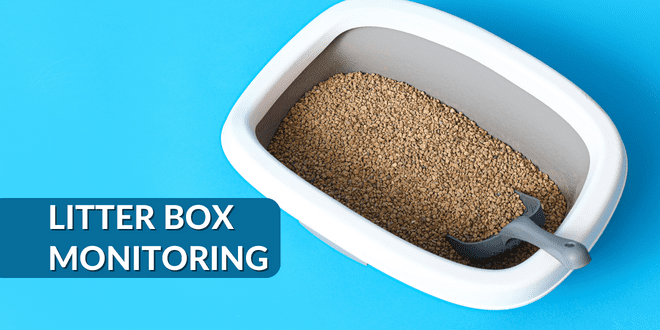
Scooping the litter box a couple times a day is not only important for keeping the box clean and your cat happy, it’s a valuable diagnostic tool. Too many cat parents are missing this opportunity to catch potential medical problems in the early stages because they’re not keeping up with a regular scooping schedule.
Time to be a Detective When it Comes to Your Cat’s Health
What does or doesn’t happen in the litter box can be a red flag indicating a potential health issue. If you’re on top of your scooping schedule you’ll be alerted to changes in your cat’s frequency of elimination, changes in appearance of the waste, or change in quantity. At the veterinary clinic one of the first questions the veterinarian will ask is whether there has been a change in litter box habits. If you don’t scoop the box regularly you won’t be able to provide that crucial information.
Cat Pee: What to Look for
If you scoop regularly, you’ll start to become familiar with your cat’s litter box pattern. Even if you have more than one cat and can’t seem to tell who peed where, the fact that you may notice a change in quantity, color, odor, or that somebody peed on the carpet, means there’s a problem needing attention.
In general, a cat eats the same amount of food each day and drinks approximately the same amount of water. If you use scoopable litter you will become familiar with the weight and size of your cat’s typical urine clump. If you start noticing the urine clump has increased or decreased in size, it could indicate a potential health problem. An increase in size could indicate the possibility of a urinary tract issue, diabetes, or renal failure, among other things. It could also just mean your cat was especially active that day or the weather was hot, but if you scoop daily, you’ll at least be aware something might need closer monitoring.
Regular scooping is an opportunity to look for other changes in the cat’s pee in terms of color, signs of blood, or change in odor. Again, these are all potential red flags.
What DOESN’T happen in the litter box is also critical information. If you are familiar with the typical amount of urine clumps you remove from the box on a daily basis and you start noticing that you’re scooping fewer ones, then it could indicate that the cat might be peeing outside of the litter box. It’s time to get out your black light and go searching around the house.
Cat Poop: What to Look for
As with the above section on urine, look for changes in volume, frequency of elimination, appearance, and odor. When you scoop regularly you will become familiar with how your cat’s stool typically looks. This familiarity will help you be alerted to early signs of constipation, diarrhea, blood in the stool, parasites, or even an excessive amount of hair in the cat’s feces.
It’s an Important Job as a Cat Parent
Investigating your cat’s litter box while scooping is certainly not one of your favorite things to do but it can make a huge difference in your cat’s health and quality of life. Don’t neglect this essential aspect of being a responsible cat parent. Your cat can’t speak up and tell you that something is wrong but you may get the message through the litter box habits. Don’t overlook the importance of litter box monitoring.
Need More Information?
If you have a question regarding your cat’s health, please contact your veterinarian. This article is not intended as a replacement for your cat’s veterinary care.
For more specific information on litter box issues, or cat behavior and training in general, refer to the books by best-selling author Pam Johnson-Bennett. Pam’s books are available at bookstores and online. We’ve included links to Amazon here on our website.

